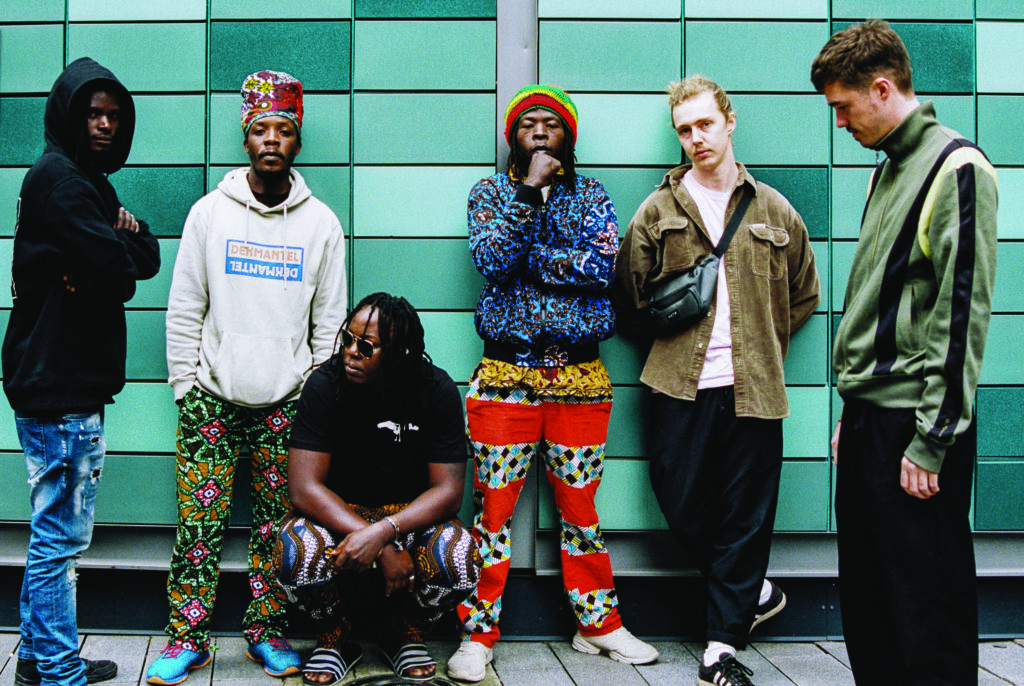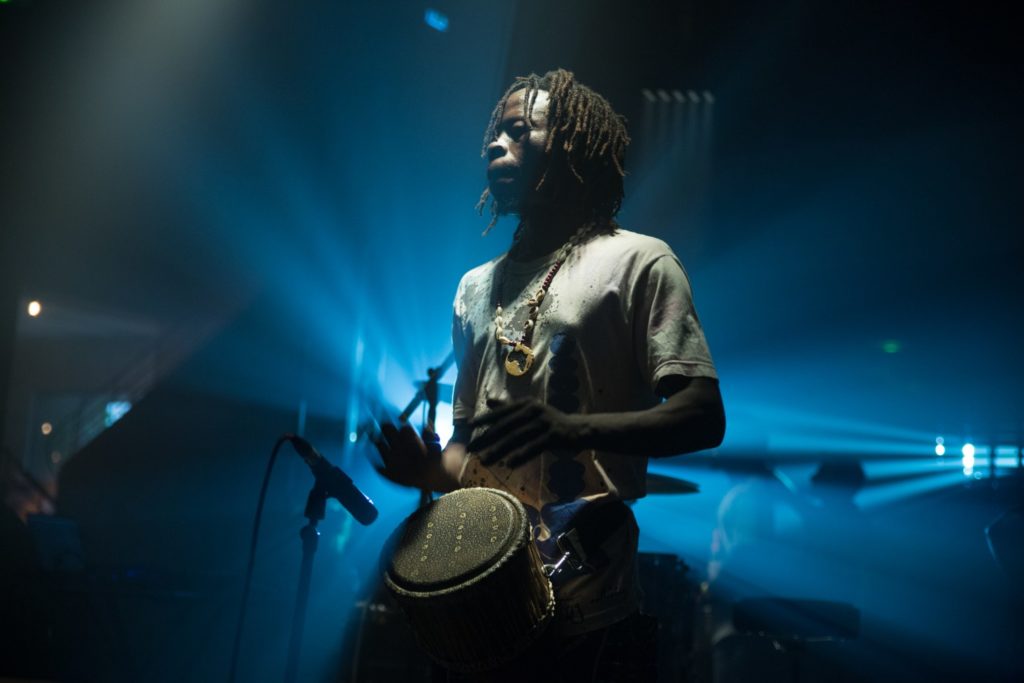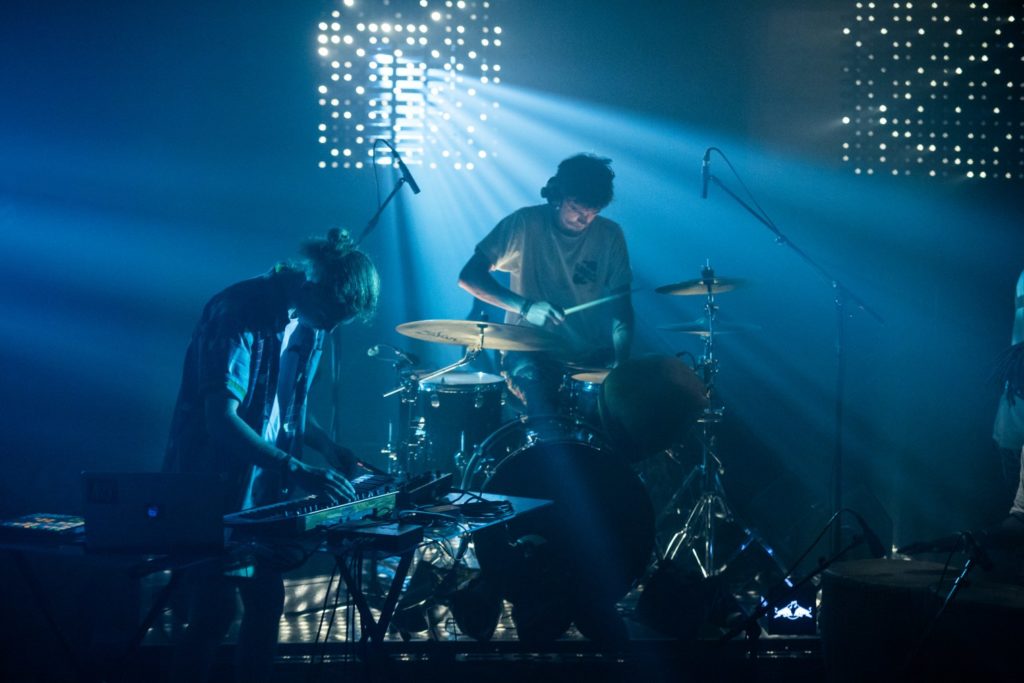
Nihiloxica is a dark electro-percussion group formed between Kampala’s Nyege Nyege Festival and the Nilotika Cultural Ensemble, a charitable organisation in the city that promotes drumming as a means of “spiritual upliftment” for the youth. In 2016, they were introduced to Peter Jones (a.k.a pq) and Jacob Maskell-Key (a.k.a Spooky-J), two English producers who travelled to Kampala to write, rehearse, and record a set of live recordings. Together, they spent a month locked away, working on a self-titled debut EP that came out through the Nyege Nyege Tapes label.
Sonically, the release harnessed the full force of the ancient drumming tradition of Uganda, reshaping its mayhem in the live environment with technoid analog synth lines. Printed on 100 limited cassettes, it marked the beginning of a long, dark conversation between two cultures, and set the foundation for a second EP, recorded live at Boutiq Studios in Kampala between October and December 2018.
Today, Nihiloxica is one of electronic music’s most original and exciting acts, and they’ve cemented this reputation with Kaloli, a debut full-length on cult Belgian label Crammed Discs. While their early releases caught Nihiloxica in a proto-typical, nascent state, Kaloli delivers road-hardened constructions that demonstrate the band’s evolution, descending deeper into the depths of Ugandan rhythms, where the music expression mutates into something sinister and nihilistic.
They were supposed to follow the release up with performances at festivals like Dekmantel and Sónar, but in the midst of lockdown, Maskell-Key, one of the group’s co-founders, chatted to EDMjunkies, discussing the story and ambitions driving the Nihiloxica project.
You’ve just released your debut album. How did you go about recording it?
We recorded the album in Bradford, in the north of England, of all places, which was different because we recorded the first two EPs in Kampala. This was the first recording we had done outside of Uganda, and so it’s a higher quality in terms of sounds. We really put a lot of time into it and focused hard on the sessions. We spent five days recording, directly after our show with Aphex Twin on September 14.
I’ve read that the release was largely written before you attended the studio. How do the releases compare in terms of processes?
For the first EP, Pete [Jones] and I arrived in Kampala with sketches already planned, like the general synth ideas, but these changed when we had everyone in the same room. The second EP was written a lot more closely with the band over a longer period of time. As for the album, it’s a mixture of old and new. We’ve been playing some of the songs since we first got together, but we struggled to fit them onto our EPs. We’ve always been so focussed on creating a more sinister sound that it took the context of an album for us to be able to explore lighter areas with more context. For example, the last track of the album, “170819,” features Jally on the flute and Pete playing nice chords. This would never have worked on a four-track EP, but as a kind of coda to the album, it works really well.
You say “sinister,” but how did you want the sound to be for these first releases?
Dark and moody? We were always focused on writing dark music, and I think we still are to some extent.
What’s your personal journey through music?
I grew up in China, and I went to school in Beijing and Shanghai. I began playing drums when I was about nine, and I studied with the percussionist from the Beijing Symphony Orchestra, and then when I moved to Shanghai I got into playing jazz, because there’s a big jazz scene there. I started playing in ensembles and stuff, and that took me to study jazz in Leeds, which is where I began to experiment with production.
How did your crossover with Uganda come?
That was through Tom Blip, who runs Blip Discs. We were living together when he started the label. I actually released a record on the label, as Spooky-J, and then Tom, Ben O’flynn (who produces as O’flynn), and I decided that we wanted to launch a project together. We found ourselves sampling African percussion and that gave us the idea of going to Africa to experience it properly. Tom reached out to Auntie Flo, who put us in contact with David Tinning, who connected us with Arlen Dilsizian and Derek Debru, who were just starting the second edition of Nyege Nyege Festival. They invited us to attend the festival and stay with them, and then do a residency afterwards, and that’s where I met the Nilotika Cultural Ensemble!
And how did Pete become involved?
We met at Leeds, where I was doing jazz and he was doing production. We were in halls and were always hanging out, and then we moved in together after university. When I applied and got funding to travel to Uganda, I was just a working musician, gigging in function bands. I was doing percussion tuition and Pete was working in a kitchen. I was going to do the project with Airhead, but he said he couldn’t do it anymore, and then one drunken night at Cosmic Slop, a legendary club night in Leeds, I asked Pete to come with me.
Talk to us about the Nilotika Cultural Ensemble. What exactly are they?
They’re an ensemble under the leadership of Jajja Kalanda, real name Peter Kalanda. The core group is between 10 and 20 people, and they teach spiritual, musical, and even tailoring practices to underprivileged communities and perform at various cultural events. They also get their own gigs and make a living from that. Kampala, where they’re from, is based in the Bugandan region of Uganda, and so they’re often referred to as Bugandan drummers, but the drums and rhythms that Nilotika play are from the whole of Uganda. Jajja runs it as a means of helping out the community rather than as a business, and that’s what drew me to the whole thing.
How clear were your visions when you started working together?
The idea was fabricated afterwards. We didn’t have any real idea about what we wanted to do, but I really liked Nilotika’s atmosphere and what they stood for, and so we stayed in touch after my first visit in 2016. Pete and I moved to Kampala in August 2017 and we ended up staying for two years, with lots of touring in between. That’s when we recorded the EPs.
What was it that attracted you to their sound?
I was blown away by the power of the ensemble. This was fuelled by the excitement of being in Africa and witnessing a performance in the courtyard of their workshop in Munyonyo, a district in Kampala, compared to a show, which is a more fabricated environment. I felt we could achieve more than just sampling the percussion, and I wanted to open up a dialogue and learn more about the music instead of just trying to recreate it myself.

Talk us through the first recording session. Take us back.
I was shitting myself a little bit, because we needed to make it work. We also had a gig at the end of it, which only added to the pressure. It’s like when you’re starting any new band: it can either click or not. With us, it wasn’t actually really clicking. We were doing stuff with a click track, so I was sending a click track to everyone, and because we had synths in sequence everyone had to stay in time. We needed a click because some synths didn’t have a pulse.
I was worried that people weren’t going to get it, but everyone really locked in with it and stayed in time. It just took persistence. We were starting at like 8am and finishing at 5pm every day for more than a month, and just honing out these sessions. We were going through the tracks and playing them over and over and over again, and getting them tighter. The tracks have actually gotten even better, I think, but there’s charm in the imperfection.
How many people were in the session, and what were you all doing
For the first EP, there were nine of us, although we’re now only six. Henry Kasoma on Namunjoloba, Jamiru Mwanje on Engalabi, Henry Isabirye on Baksimba drums, Aienomugisha Alimansi Wanzu on Engalbi and shakers, Pete on synths, and myself on drum kit and electronics.
How hard was it to coordinate the Ugandan drumming with electronics?
I think the trick was to not add too much. With so many drums going on, you are covering a wide spectrum of sound so Pete was tasked with fitting himself around it. The Ugandan drum set which we use is a complete package all by itself, so a lot of our workflow revolves around adapting ourselves to it, and trying to fit in the natural spaces that occur within the traditional rhythms. All the drums also have their own pitches, which makes writing harmonies difficult sometimes, especially as the drums go wildly up and down in pitch depending on temperature and climate! I think for this reason Pete’s love of dissonance really was a blessing.
How prepared were you for the sessions?
We went over with three ideas, which became “Nilo Chug,” “Endongo,” and “Choir Chops,” which was a track I wrote for myself originally but turned it into a track for Nihiloxica. For “Nilo Chug” and “Endongo,” these sketches were literally a bassline that we used as a starting point, and “Choir Chops” was more a written song that we restructured to suit the band setup. “Kadodi” was written as a band, because it’s a traditional Kadodi rhythm.
Did it take long for the sound to develop?
It came together in the first month of rehearsals. I think the sound is down to Pete’s synth work and the raw production on the drums. He uses the Korg Minilogue, which he knows extremely well, and we’re restricted in some ways to that sound. We also don’t embellish the recordings too much. What you hear on the recording is what we do live in the moment, no extras. I think this rawness has helped to communicate our idea.
Another thing is that Ugandan percussion is quite straight-forward, compared to West Africa. The West African stuff is more intricate with changes and passages that the music goes through. With Ugandan percussion, it’s repetitive and that gives it this trance-like state. You can listen to the drums go over again and again until there is a cue for a change that brings you out of it, and then it starts again and you’re brought back in. That’s basically what we’re playing off.
What’s the story behind the name, Nihiloxica?
It’s a combination of “Nilotika,” “nihilism,” and “toxicity.” Nilotika is the name of the original ensemble and a tribe native to Uganda and river Nile. “Toxicity” relates to an unnatural marriage of sound. “Nihilism” is the no fucks attitude, meaninglessness and the zen zone of accepting, somewhat like mindfulness.


Were you surprised by the success of the first release?
I was, actually. I went out with the intention of doing this project and trying to get some gigs, and I totally didn’t expect the reception that we had. We had been mixing it and spending all this time making it sound good, and I think that made me lose some enthusiasm, but that came back to me when it was released.
What do you think makes Nihiloxica stand out from a crowded musical landscape?
I think the idea is simple but effective. I did not want to over complicate the setup, as I know from experience with live electronic projects that more gear means more problems. Also, there’s the ethos of the band: this was intended to be a live project, taking influence from electronic music that had sampled African percussion and turning it on its head by starting a band and creating a dialogue.
How closely do you stick to the tracks when you play live?
We always perform our tracks, but things can get switched up a little bit live. The Ugandan approach to a rhythm is more as a kind of framework than a set pattern, so we will never play the same thing twice. We take a lot of solo sections, and Pete is pretty much always going off on one with the synths, so I think you could say we have a raw, unpredictable energy that we channel while we play. Recently we have been doing some even more improvised stuff as encores. For example, Spyda has a couple songs that he has performed with Nilotika, so Pete and myself improvise around it live. It’s fun because it allows us to respond to the energy of the crowd more.
The project touches on many different scenes. What are your ambitions with it?
We have some ideas about what we would like it to be. Pete and I have always wanted to make it more metal, and we tried this with this album, but we are not trying to push it unnaturally. I came from a metal background, before jazz, and the album feels like a nice combination of both. We are also happy with some of the new stuff that we are writing because it is more metal, and taking flight from the original sound and not just straight up techno. There’s more proper polyrhythmic stuff going on, and intricate arrangements and stuff. We’re also experimenting with some vocals, as one thing that is different with our live shows is that Spyda takes the role of the MC and has been singing a lot more. This is something we’re really sure we want to get right before we go ahead with it, and it’s something a lot of people mention, so we’ll see.
What can we expect from Nihiloxica next?
Hopefully, you can see us live in November! Other than that we will be working on our next album, and following this release we are full of energy and ideas. So more. Lots more.
Left to right in lead photo (real name (nick name)) | Henry Isabirye (Isa), Henry Kasoma (Prince), Peter Jones (pq), Jamiru Mwanje (Jally), Aineomugisha Alimansi Wanzu (Spyda), Jacob Maskell-Key (Spooky-J)
Photos by Will Leeming, unless mentioned otherwise.